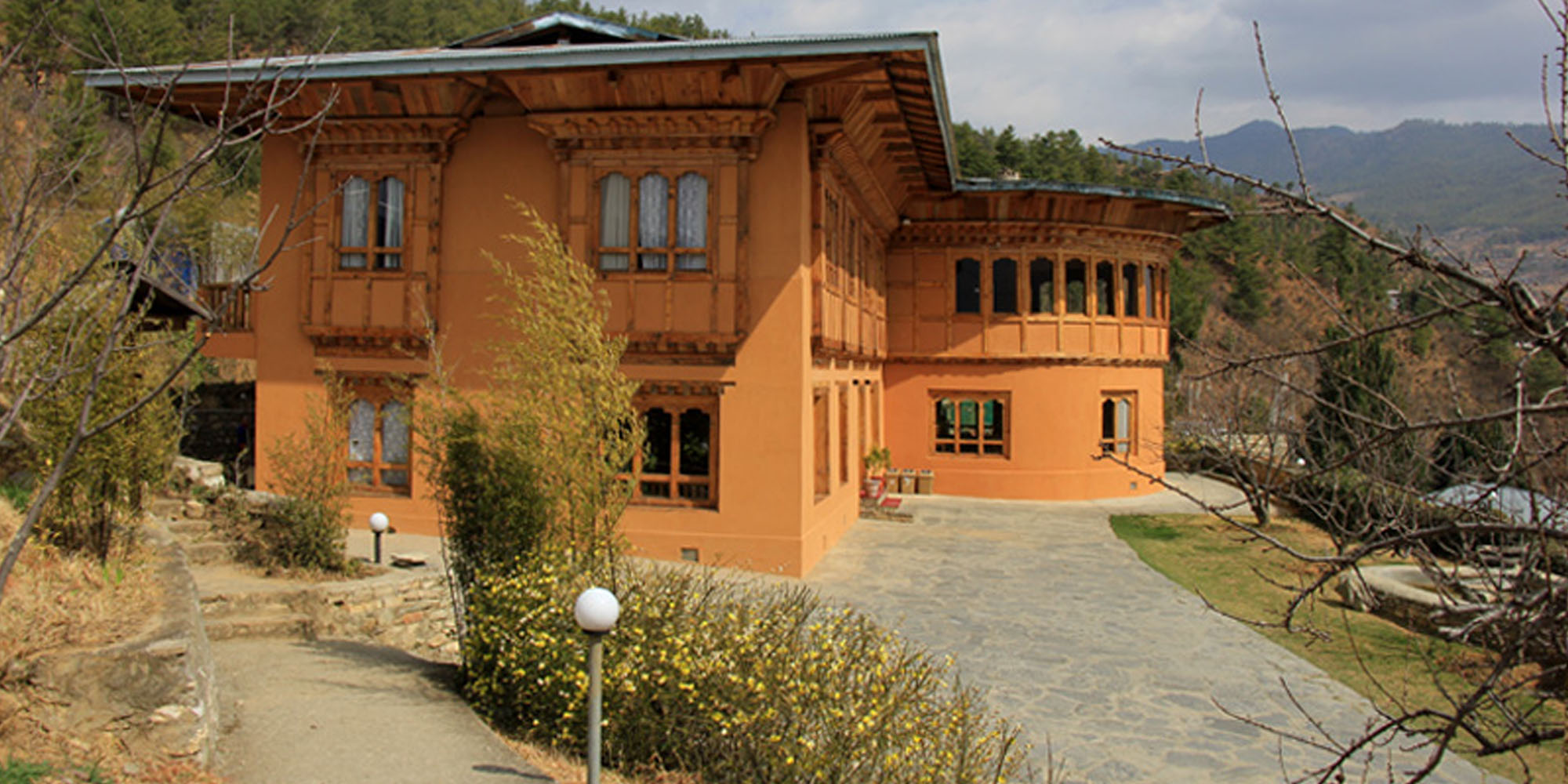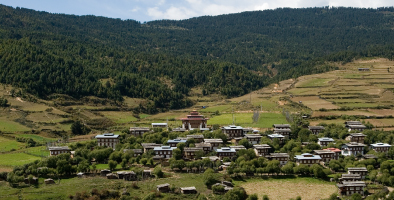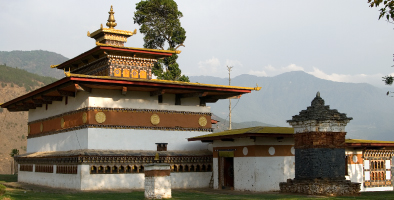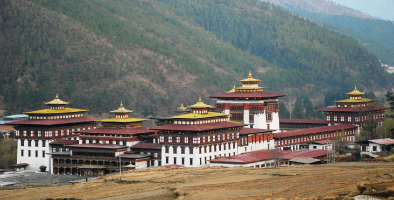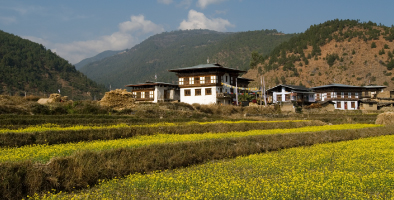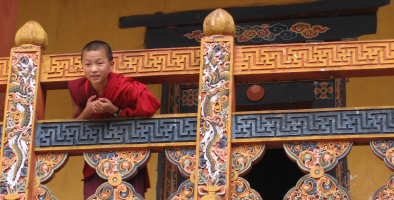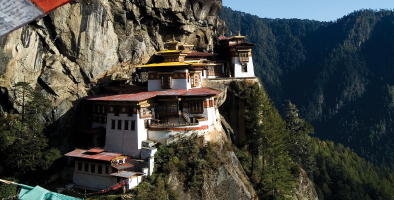- Hotels
- Meals
- Sightseeing
- Transfers
2 Nights in Hotel Phuentshopelri, Hotel River view, Hotel Gyakil or Similar in Thimphu
2 Nights in Hotel Olathang, Dewachen Resort, Rema Resort Similar in Paro
Hotel Phuentsho Pelri, Thimphu
Rema Resort, Paro
CP (Daily Breakfast included in all the Hotels)
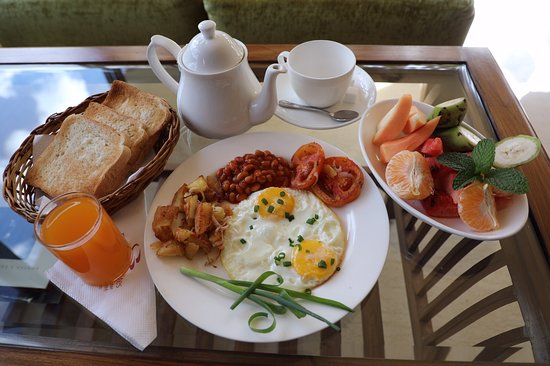
Thimphu: Visit to Changangkha Lhakhang, Royal Takin Preserve, Memorial Chorten, Buddha Dordenma, Folk Heritage Museum etc.


Paro: Visit to Taktsang Monastery, National Museum, Rinphung Dzong etc.

Mode of Transport
01 – 03 Pax – SUV
04 – 07 Pax Toyota Hiace
08 Pax & above – Toyota Coaster bus
*Non-AC
*Non-Disposal



A Magical Kingdom Tour
Scenery, culture, and adventure – want them all? Come join us on this 05 Days fascinating trip. Magical Bhutan Tour has all the ingredients of a fulfilling and memorable Bhutan experience.
We’ll take you amid the breathtaking landscapes of mystical Bhutan and let you explore mountainous roads, valleys, rice paddies, and lovely towns. Witness pristine rivers meet in this scenic region of magical Bhutan. Get up close with exotic flora and fauna.
As we hop from one beautiful town to another, you get to visit several architectural wonders in picturesque settings. Won’t you like to visit the dzong (castle-monastery) where all the heirs of this Buddhist kingdom were crowned?
And do you know how the Bhutanese lived more than a hundred years ago?
Spend time learning about the culture of this otherworldly country as you experience Bhutanese hospitality.
Fulfil your adventure lust, exploring wild, glacial landscapes and remote villages of beautiful Bhutan. If that’s not enough, take an incredibly steep hike to a cliff-top monastery. Savour Bhutanese food and take healing baths for the ultimate Bhutan experience.
Day 1
Arrive in Paro. Drive to Thimphu (2500m), the capital of Bhutan. Overnight stay in Thimphu
As you start your journey on the early morning flight to Bhutan, get ready to feast your eyes on surreal sights.
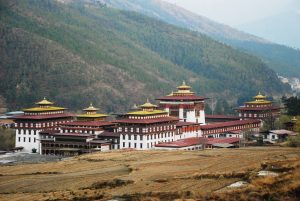
First, the towering, scintillating, and scenic Himalayan glacial peaks. And then, on entering wonderful Bhutan, the dense green, attractive Paro Valley with the shimmering, pristine Pa-chu (Paro) River meandering through it. You’ll also get the first glimpse of two significant dzongs (fortresses), two of the must-visit tourist places in Bhutan. Ample spectacle to keep you entertained for like an hour!
While alighting from the aircraft, feel the air in this tiny, remote kingdom shaking off all the dirt. Yes, the first welcome here is from Bhutan’s fresh Himalayan air. Bhutan, a carbon-negative country, promises minimal carbon dioxide throughout your stay here.
Welcome to the Happiness Kingdom
Now that you’ve entered the happy land of Bhutan, fill up the immigration form at the airport’s arrival terminal, hand it over to the immigration official, and you’re good to go. Our tour guides in Bhutan can’t wait to see you!
Look forward to a traditional welcome from our representative, waiting for you at the airport’s exit terminal. After you collect your baggage, you’ll be taken to the waiting vehicle.
After a scenic flight offering a one-of-a-kind Bhutan introduction, you’ll now experience an exceptionally pleasant drive from Paro to Thimphu. Take in the picturesque countryside – Rivers Paro and Wang Chu (Thimphu), Chuzom, which is their confluence, as well as timeless hamlets such as Kharbije and Namseling. Simtokha Dzong, a small, beautiful fortress, gives you the first glance of Thimphu city.
On reaching the hotel, check-in and freshen up. Next on the agenda – a delicious lunch at one of Thimphu’s nicest restaurants. Get introduced to Bhutanese foods, not to miss Ema Datshi (chillies-and-yak cheese stew), Bhutan’s national dish.
Let’s sightsee a bit.
Post lunch, our tour guide in Bhutan will take you to Changangkha Lhakhang, Thimphu’s earliest monastery. This 13th-century, hillock-perched Bhutanese masterpiece overlooks the stunning Thimphu Valley. It’s an age-old family tradition in Thimphu to name newborns at Changangkha Lhakhang and seek blessings from Tamdrin, the protector god.
There’s every chance that your visit to the monastery might coincide with a local family’s, along with their bundle of joy. Watching them perform the rituals here will be sheer joy.
You can’t but admire the Lhakhang’s focal point – the eleven headed, thousand armed statue of Avaloketesvara (Buddha of Compassion), made of bronze and given a gold plating.
At this holy place, why not wish for something good for all living beings in a special way? The ritual practised here is to keep some cash notes (of say Rs. 10) on a dice plate and toss the dice together on it. You’ll know from the monk what good the numbers will bring.
Now it’s time to meet the exotic Takin at the Royal Takin Preserve. This fascinating creature has a goat-like head and a cow-like rear. It’s the national animal of Bhutan. The local myth here is that the 650 kg endangered takin is a much-loved saint’s creation. Aren’t you keen on seeing the takin at a very close range? Just wait till it comes for food near the fence.
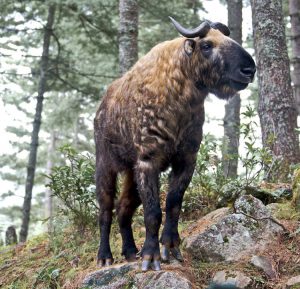
Next, we take you to the hilltop-perched Bhutan Broadcasting Service (BBS) Tower to enjoy the fantastic sights of Thimphu city.
It’s your first day in Bhutan, and we know you’ve been up very early this morning. So, let’s end our sightseeing trip with a short visit to the 17th-century Tashichho Dzong, Bhutan’s chief secretariat building. An exemplary piece of Bhutan architecture, Tashichho Dzong houses the King’s throne room and numerous administrative offices. In the summer season, Bhutan’s central monk body prefers to reside in this massive fortress.
Now let’s go back to the hotel for a relaxed dinner and a much-needed sleep.
Day 2
Full Day Tour of Thimphu. Overnight stay in Thimphu.
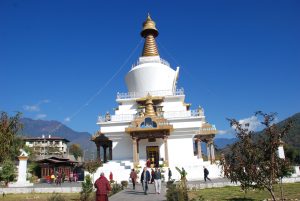
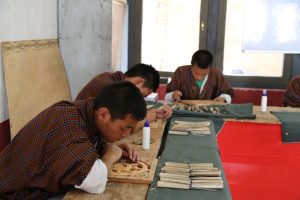
Hope you all are charged up! Today, we have plenty of sightseeing in store for you. With the hotel’s nutritious breakfast as fuel for your morning tour, let’s first visit one of Thimphu’s most famous landmarks built in honour of the founding father of present-day Bhutan. It’s the Memorial Chorten, a towering, four-storeyed monument with statues and symbolic representations of Tantric gods. Just step inside the shrine to witness a fantastic sight of folks of all ages engrossed in worship. Watch the locals as they go around the Chorten, holding the prayer wheel and murmuring words of prayer.
Now, although difficult, you’ll have to disengage from the fascinating scenes because the world’s most giant published book is waiting to be admired at the National Library. Besides this piece of wonder, the 20th-century library also houses significant historical records and pictures.
We break for lunch before proceeding to the Royal Textile Museum. This 21st-century building, established with the Queen Mothers’ backing, preserves Bhutan’s rich textile culture. Peep into royalty, admiring beautiful textiles like the crowns and apparel worn by the Kings of Bhutan. Your visit also includes an introduction to required weaving methods and the local dressing style.
We had something exciting in mind while selecting a Saturday for today’s trip. A vibrant weekend market! Yes, the Centenary Farmers Market is a must-visit. With about four hundred stalls, it’s Bhutan’s biggest farmers market and attracts farmers from every corner of the country. Catch the Bhutanese vendors in action in your camera as they sell a variety of Bhutanese goods as well as regional organic vegetables. Interact with the natives and learn what goes into a typical Bhutanese diet.
After the friendly conversations with Bhutanese farmers, we want you to get familiar with their ancestors. Step into an ancient home of amazing Bhutan. It’s more than a hundred years old. This traditional house, also one of Thimpu’s oldest, is the present-day Folk Heritage Museum.
The museum has beautiful exhibits of traditional Bhutanese kitchen tools and utensils used by the forefathers. Just some time ago, you learnt about the local vegetables at the farmers market. Here, you’ll find a display of ancient kitchen gardens, telling you which vegetables the Bhutanese ancestors preferred for lunch. Then there’s the ancient watermill as well as the hot stone bath on display. Isn’t the museum visit a unique Bhutan introduction, retracing the country’s past nearly 150 years before today?
Now let’s take you to the painting school to learn about the thirteen crafts of wonderful Bhutan. At the National Institute for ZorigChusum, watch young Bhutanese students take vocational training in crafts like wood carving and embroidery. Can’t take your eyes off that beautiful woodwork put up for sale? Go for it. A fair price guaranteed!
Next in line is a visit to the National Institute of Traditional Medicine, a significant contributor to sustainable Bhutan. The centre gathers medicinal herbs from faraway patches of the Bhutanese Himalayas and prepares medicine from roots, leaves, flowers, etc. Bhutan’s healthcare units receive herbal medicine from this facility in different forms like pills and teas.
We have planned to take you to yet another sacred spot in Thimphu. Come face-to-face with one of the world’s largest sitting Buddha statues and also a significant pillar of Bhutan gross national happiness. The colossal, peaceful Buddha Dordenma sits 51.5 metres high and holds 1,25,000 smaller Buddha statues. This bronze sculpture with a thin paint of gold sits upon a throne which serves as a huge meditation hall.
One of the most famed things to see in Bhutan is its postal stamps. So, we must take you to the post office. Who knows, you might develop a passion for philately, thanks to the Bhutanese stamps. We’ll also take you to the nearby museum that exhibits Bhutan’s postal history as well as its progression.
Today, sending non-electronic mails is a novelty. Why not send a stamped postcard to your loved one back home? You can even get your own photographs printed immediately at the post office. How about personalising the postal card with some of these pictures?
Yesterday, didn’t you buy handmade paper as a souvenir? We’ll take you where it’s made. That’s the Jungshi Handmade Paper Factory, one of Bhutan’s oldest. Jungshi is Bhutanese for “natural”. Learning the age-old Bhutanese tradition of papermaking is one of the most interesting things to do in Bhutan.
At the factory, observe every step of papermaking closely, right from the raw material (tree bark) to “Desho”, i.e. the finished product. How about trying your hand at papermaking? Preserve your own creation for years to come!
Traditionally, monasteries used the Desho paper for writing manuscripts and prayer books. Now you’ll find plenty of Desho souvenirs, including envelopes, lampshades, and bags at the little shop here.
You’re touring the Happiness Kingdom. Let us know if you’re keen on understanding Bhutan gross national happiness conceptually. In that case, we can make arrangements for an informal meeting with the relevant officer.
What better way to end the day than to shop for interesting Bhutanese souvenirs? Stroll through the Handicraft Market and buy Buddhist cloth paintings, yak wool bags, handmade paper, and colourful prayer flags from many of the hundred shops. What’s more, you get everything at a fair price.
After picking up amazing things for yourself and your near and dear ones, let’s return to our hotel.
By the way, did you notice how the Bhutanese traffic system works? You didn’t come across any traffic lights because there aren’t any throughout the country. On our way back to the hotel, note how gracefully traffic policemen show signs to the main traffic. Neatly dressed and using white gloves, the traffic police with their elegant mannerisms are indeed a sight to behold!
Day 3
Thimphu - Paro. Overnight stay in Paro.
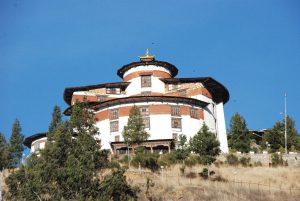
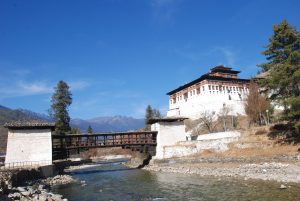
After two fun-filled days in Thimphu, we descend towards Paro town (1400m), our entry point into amazing Bhutan. Paro lies in the thick, flourishing Paro Valley, in the backdrop of pristine mountain ranges. The hour-long drive to the breathtaking Paro Valley is a unique Bhutan travel experience, along crystal clear rivers and magnificent monuments.
On this fascinating journey, we’ll spend some time at Chuzom. As you already know from our trip on day 1 (Paro – Thimphu), Rivers Thimphu and Paro meet at Chuzom. You’ll enjoy walking on the Chuzom bridge. Also, at this fascinating spot, you’ll find three stunning chortens of Tibetan, Nepali, and Bhutanese styles. We’re going to have a tough job interrupting your photography and reminding you to get inside the waiting vehicle!
As we resume our journey in the direction of Paro, just a short while from Chuzom, you can spot the eye-catching Thamchok Lhakhang. It’s a private temple under the ownership of a renowned iron chain bridge builder’s scion. You can see the great man’s creation even here – a fantastic chain bridge that leads to the temple.
Watch out…we’re suddenly approaching a wide opening through the mountains. Yes, we’re descending in the picturesque Paro Valley of magical Bhutan. You’ll see the pristine Paro River winding through it, lush green landscapes dotted with paddy fields and multicoloured flowers, and fruit orchards patterning the valley. Isn’t it now easy to understand why describing the beauty of Paro is beyond words?
We check into the hotel, freshen up, and gather for lunch before we begin our sightseeing trip. First on the list here is the National Museum. This hill-perched museum preserves the rich Bhutanese culture in the form of countless collections. Fine arts, bronze sculptures, jewellery, stuffed animals, stamps, and the list goes on. Another plus point of your museum visit is the spectacular view of Paro Valley from its viewpoint.
Now let’s go downhill to explore the majestic Paro (Rinpung) Dzong. This 17th century, square-shaped citadel with a central tower and motifed buildings is indeed an exemplary piece of Bhutan architecture. Paro Dzong is the administrative centre of the town. It houses courtyards, administrative offices, and a monastic area.
For an ultimate Bhutan travel experience, let’s walk on the typical cantilever bridge over the Paro River. Note the traditional construction – a shingle roof, cantilevers (beams) fastened with one river bank and stretching out horizontally to the other edge, and 2 guard-houses at both ends. Once we cross this fine Bhutanese specimen, our waiting vehicle will take us back to the hotel.
Day 4
Sightseeing and overnight stay in Paro
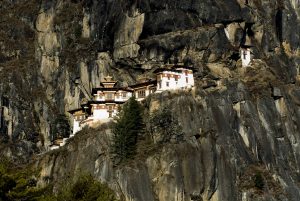
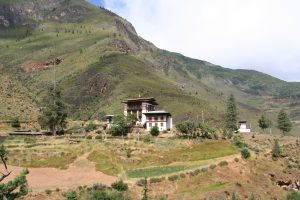
Today, it’s all about Paro! Post breakfast, we take a short drive on a blacktop road of green Bhutan to the end of Paro Valley. This is where the 17th-Century Drukgyel Dzong stands. A symbol of victory over the Tibetan aggression, Drukgyel Dzong served as an excellent barrier for several years against further attacks. Today, we can see only the ruins of this fortress because it had caught fire and suffered heavy damage in 1951. However, the well-protected ancient ruins make an impressive sight, qualifying as Bhutan’s most stunning archaeological spot!
We take you to the end of the blacktop road and then along a narrow path to Lingshi, a remote Bhutanese village that yak herders call home. Today, if Weather God is on your side, you’ll be able to get a clear view of the snow-clad, towering (23,996 feet) Mt. Jomolhari. This spectacular mountain, also regarded as the holiest peak in beautiful Bhutan, provides a perfect backdrop to the Drugyel ruins and Lingshi.
Coming up is one of the best parts of your Bhutan Tour! From Lingshi, we retrace about 6 kilometres to take in breathtaking views of Taktsang Lhakhang, more popularly called “The Tiger’s Nest”.This iconic monastery is so-called owing to the myth that the medieval Buddhist saint Padmasambhava visited it, riding a flying tiger. The legend also says that he meditated in a cave that is now the Nest’s lower storey. The monastery houses a wrathful emanation of Padmasambhava on top of a tiger.
For adventure enthusiasts, the Tiger’s Nest excursion could be one of the most memorable Bhutan Treks. You can reach this sacred place only through an uphill hike as it’s perched on a precipitous rock face. It’s a 5-hour trek through scenic pine forests, with the eluding view of the Nest beckoning you the whole time..
So, are you game? We’ll take you uphill through the well-marked trail till we reach our lunch point after about 3 hours. Enjoy unique views of the monastery from here. If you’re hell-bent on visiting the monastery, we’ll take you further uphill for another couple of hours.
After taking countless pictures of the Taktsang, we return to our starting point, downhill along the same trail.
Next, we’ll take you to Paro town. You can explore it at your leisure. But something is interesting on the way back from the dzong to our waiting vehicle. Take the experience of crossing the traditional cantilever bridge with a shingle roof and a couple of watch houses on each end.
In Paro town, enjoy local cuisine like steamy momos. Else, visit one of the finest restaurants that serve sophisticated Bhutanese foods, such as Ema Datshi (Bhutan’s national dish). Shop for souvenirs at the Paro Craft Market.
You can relax your muscles and rejuvenate your soul in a traditional hot stone bath here. While preparing a Bhutanese hot stone bath, the locals collect specific river stones and heat them up in an open fire till they get a blood-red colour. After filling cold water inside the conventional wooden tub, the natives dip these red hot stones in the water until it warms up. While adding herbs to the warm water, each Bhutanese family has their own secret recipe, followed across generations.
After an unrushed, healing bath, we return to the hotel. Enjoy the last dinner together before we all part ways.
Day 5
Paro - Onward Journey
We bid goodbye to beautiful Paro and, in fact, to beautiful Bhutan. We board the flight on an onward journey from the Paro International Airport and then come back home with treasured memories of unforgettable Bhutan.
Let us know if you wish to discover Bhutan again with us. We’ll be only too glad to assist.
INCLUSIONS:
- Bhutan Sustainable Development Fee (SDF)
- Accommodation on twin sharing
- Breakfast at the hotels listed
- Certified English speaking guide throughout the tour
- Transfers and sightseeing on private as per the itinerary only (Vehicle, NOT at disposal)
EXCLUSIONS:
- 5% GST as per Indian Government Notification
- 5% TCS as per Indian Government Notification with Pan card
- Lunch, Dinner and snacks
- All entrance fees to museums and monuments
- Flight Tickets
- Personal Insurance, evacuation and medical expenses of any kind
- Expenses of personal nature like bar bills, telephone calls, laundry, extra mileage and any extra costs incurred due to natural calamities, flight delays etc.

